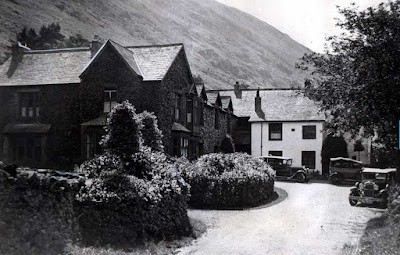I remember my uncle, the farmer (see Aunty Bina’s Farm), explaining why he preferred certain fields for crops, and others for his “be-asts”. Potatoes, sugar beet, and wheat grew best on warp land, whereas the cattle grazed on pasture.
I may be mistaken, but looking now on Streetview, I fancy that the line of the low bank around the field followed the line of the lane. The fields were for crops, while the cows grazed behind the house.
But thinking about it now, it puzzled me. The buildings in the far distance are on the other side of a railway line, and there is a canal beyond that, with the river at the other side of the canal. How could the river water have been diverted into the fields?
Perhaps the water came from a different river. The River Aire is around two miles to the North behind the camera, and the River Ouse about three miles to the East, but I think these would have been too far, and several main roads, the villages of Rawcliffe and Airmyn, and the town of Goole were in the way. My guess is that the warp water must have come from the river beyond the railway, canal, and buildings - the Dutch River (or River Don).
Wikipedia provides an answer: “The first reliable report of warping seems to come in the 1730s from Rawcliffe, which is near the confluences of the Ouse with the Aire and the Don, where a small farmer called Barker used the technique.” Neither the railway nor the canal would have been there then. The Knottingley and Goole Canal was opened in 1826, and the Wakefield, Pontefract and Goole section of the Lancashire and Yorkshire Railway in 1846. The warping must have been done before these dates. Some of the brick outhouses at the farm could easily have dated from that time, and knowledge of the warping would have been passed down by word of mouth.
The railway, canal, and Dutch River can be seen running parallel in the lower left quarter of this 1962 map (pre-motorway). The oddly straight Dutch River is clearly another man-made feature. It was constructed in the 1630s by Dutch engineers, who diverted the River Don to drain the moors of Hatfield Chase, hence the name “The Dutch River”. The River Don originally flowed further East into the River Trent. Warping of my uncle’s land must have used water from the diverted river Don.
More extensive warping schemes were carried out in the Nineteenth Century along the original course of the Don, as far East as Adlingfleet on the Trent, and as far South as Crowle. One large area is served by the enormous Swinefleet Warping Drain (centre bottom of map) which runs for 5.6 miles (9 km) and has a permanent sluice into the River Ouse. The drain and much of the network of drainage ditches are deep and wide. Some are stocked with fish for anglers, and all provide habitats for frogs, sticklebacks, water voles, and other wildlife. It is astonishing to think it was all dug out by hand. But, we do not only alter our landscape. Families with Dutch names still live in the area, and the local name for drainage ditches is dykes.
 |
| Swinefleet Warping Drain |
 |
| Swinefleet Sluice where the warping drain enters the Ouse |
Two areas of unreclaimed land remain just to the South: Thorne and Hatfield Moors, which together form the largest expanse of lowland peat bog in the country. Even the intrepid Yorkshire Pudding’s Geograph project has not much ventured there.
One last piece of trivia. In the film “The Dam Busters” (1955), the aeroplanes are shown flying along a Dutch canal. It was actually filmed flying East along the Dutch River. The Goole shipyard cranes can be seen as the planes approach the River Ouse and then bank left over the town. Please don’t tell the East Riding Council. It will give them ideas about what to do with the place.
Dave Northsider is now trying to work out how he can divert river water into his polytunnel.





